

MAPPING CREATIVE HEALTH IN ESSEX


Exploring the Role of Creativity in Health and Wellbeing
Research report prepared for Essex County Council by Creative Lives - March 2025





Exploring the Role of Creativity in Health and Wellbeing
Research report prepared for Essex County Council by Creative Lives - March 2025
This report maps the creative health landscape across Essex, examining how arts and cultural activities can contribute to health and wellbeing outcomes in the county. Commissioned by Essex County Council and conducted by Creative Lives between April 2024 and February 2025, the research provides crucial insights into current provision, challenges, and opportunities within Essex’s creative health sector. This reports begins to explore how the creative and cultural sector can strategically improve health outcomes in Essex.
Our methodology combined extensive qualitative and quantitative approaches, including five focus groups with 47 participants, eight in-depth interviews, and a survey yielding 45 responses. Further to this, extensive desk research explored population demographics of Essex and the national context for creative health. Additionally, we created a comprehensive database documenting over 53 creative health initiatives across the county, revealing a rich tapestry of activity ranging from grassroots organisations to established cultural institutions. The research suggest there are in fact many more local creative health intiatives, especially small grassroots and informal creative groups. Our survey found a strong visual arts and crafts representation and activities to support people over 65, and activities to address mental health needs.
The findings highlight Essex’s vibrant creative health ecosystem, characterised by strong local leadership, collaborative partnerships, and diverse cultural programming. The research identified significant opportunities, including:
1. Potential to reduce health inequalities through strengthening strategic partnerships.
2. Enhance social prescribing pathways.
3. Leverage Essex’s proximity to London, whilst developing local talent.
Critical challenges persist, however, including:
1. Inconsistent funding mechanisms.
2. Geographic disparities in provision.
3. Barriers to accessing services and opportunities, particularly in rural and deprived areas.
“In Essex there is incredible creativity, and people giving voice to who they are and where they come from, and shaping their community through arts practice” (Interview Participant)
The report outlines several key recommendations, including:
• Adopting the Culture, Health and Wellbeing Alliance’s Creative Health Quality Framework,
• Developing sustainable funding models,
• And strengthening cross-sector collaboration between cultural and health organisations.
We identified a particular need for enhanced training and skills development, improved evaluation methodologies, and the establishment of Creative Health Action Zones to encourage place-based initiatives.
Our analysis reveals that Essex is well-positioned to become a leader in creative health, building on its existing cultural assets and strong volunteer network. To realise this potential, it will be necessary to address structural barriers, improve transport accessibility, and develop more cohesive approaches to commissioning and delivery. Integrating creative health into broader public health strategies could significantly enhance health outcomes and develop more resilient, connected communities across Essex.
This report provides a foundation for strategic action, offering practical recommendations to strengthen Essex’s creative health sector while ensuring its benefits reach those most in need. The insights gathered demonstrate the transformative potential of creative health interventions and their vital role in addressing key public health priorities across the county.

“Things are fragile, but in the last five years, they have changed beyond recognition […] so it feels like the time is right.”

Summary recommendations include:
1. Build on regional and local strength and excellence to establish ‘Creative Health Action Zones’: Enhances civic pride and creates spaces for needs-based, community-driven creative health activities.
2. Establish formal highlevel partnerships between Essex County Council, Essex Health and Wellbeing Board, Integrated Care Boards, regional NHS and Public Health bodies and the cultural sector: Embeds creative health into strategic health initiatives, addressing gaps in collaboration and integration.
3. Address current training and development needs by focusing on joint commissioning and evaluation opportunities, training, and skills development that brings health and culture professionals together: Equips practitioners with the tools needed for impactful work and strengthens crosssector collaboration.
Creative Lives was commissioned by Essex County Council to map the current creative health provision and explore the role and potential impact of creative health across Essex.
Creative Lives is a registered charity that was established in 1991. We champion community and volunteer-led creative activity, and work to improve opportunities for everyone to be creative. In particular, we celebrate and promote people expressing themselves creatively with others, recognising the benefits this can bring.
www.creative-lives.org
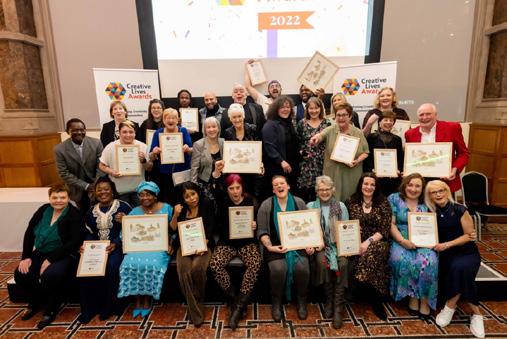
Creative Lives adopted a collaborative, open conversations approach to this brief, working with the creative health sector in Essex. Jess Plant (Creative Lives’ Place Director) led the project with support from Gareth Coles (Creative Lives’ Profile Director). They brought together a team of experts including Damian Hebron (Consultant, formerly Head of Arts at Cambridge University Hospitals and CEO of London Arts and Health) and Natasha Richards-Crisp (Freelancer Researcher and Creative Practitioner). Creative Lives also worked with Data Culture Change to explore postcode and health outcomes data. The team has collaborated with the East of England Creative Health Associate, Olivia Dean, from the National Centre for Creative Health (NCCH) to ensure this report has a legacy.
The project ran from April 2024 to Feb 2025. The findings in this report include pre-existing nationally available data from a range of sources including the census, local council information, Arts Council England, and Creative Health Research. We have also collected local data through a range of both qualitative and quantitative approaches.
Creative Lives incorporated varied methods detailed below, alongside desk-based research, to contribute to the project’s findings and outputs. The conclusions were formed based on analysis of key themes and insights across the different methods and approaches. You can learn more about our methodology in Appendix A.
Part of our methodology involved creating and filling a mapping database of creative health activity with over 53 entries derived from desk research, alongside other qualitative and quantitative methods of data collection, over an eight month period. This database will be available via a passwordprotected spreadsheet from Essex County Council (ECC).
Throughout this report, we have featured case studies, which seek to demonstrate the rich variety, scale, and quality of creative health provision in Essex. These case studies demonstrate the potential of creative health in improving health outcomes across the county, which if fully realised could be transformational. Thank you to all those who contributed insights, ideas, time, images and case studies to this report.
A key theme of the Essex County Council Cultural Strategy is the significant role culture plays in addressing issues around health and wellbeing. Essex County Council (ECC) Culture Service wished to consider the potential of arts and creativity to contribute to health and wellbeing outcomes, what is currently taking place, and what opportunities and issues there are within the sector.
This report is for policy makers, health professionals and those working in the cultural sector and those who have a responsibility for the health and wellbeing of the Essex population. This includes the NHS, Health and Social Care, and Public Health professionals. It also aims to inform researchers, artists, practitioners, heritage/cultural organisations and Voluntary, Community and Social Enterprises (VCSEs) within and beyond the county with an interest in health and wellbeing outcomes.
This project seeks to explore a number of gaps, including:
• Lack of a unified definition of good practice in culture-led health and wellbeing activities.
• Inconsistent mapping and documentation of current activities and their outcomes.
• Limited understanding of funding sources and sustainability of current projects.
• Insufficient data on the success factors and potential scalability of existing activities.
• Gaps in skills and training among practitioners and leaders in the culture and health sectors.
• Need for stronger partnerships between Essex County Council, NHS, and Public Health bodies.
• What activity is currently being delivered in the creative health sector across Essex, and how is it funded, reviewed, and sustained?
• What does good practice look like in creative health, and how can it be defined, shared, and potentially scaled up?
• What are the workforce and volunteer needs regarding support and skills development?
• How can we strengthen the case for creative health in the region, and what strategic levers can be used to ensure future investment?
The potential limitations for the project included challenges in gathering comprehensive and accurate data across all relevant activities, and difficulty in achieving buy-in from all necessary stakeholders, particularly in aligning goals between cultural and health sectors. There is also a need to acknowledge that the geographical span, and diversity of citizens, presents a challenge to viewing Essex as a unified place. To address these potential limitations, Creative Lives acknowledged the scope of the work as a snapshot of current work being conducted rather than aiming for a complete picture. The approach to the project provided multiple avenues for stakeholder engagement to increase the potential for participation from relevant parties.
Additionally, we conducted a Sense Check event with relevant stakeholders to further explore solutions to the project’s challenges, and to ensure the applicability and sustainability of the report’s recommendations. It is also important to acknowledge that this work took place against a backdrop of the cost of living crisis, a national election and the ongoing repercussions of the pandemic. Essex County Council like many other areas is also exploring many budgetary restraints and infrastructure challenges that impact the culture and health spheres significantly.
• A practical, simple, working definition for good practice in creative health activity
• A shareable database resource mapping creative health activity across Essex
• A report summarising findings in a high-quality format, to share with relevant stakeholders.
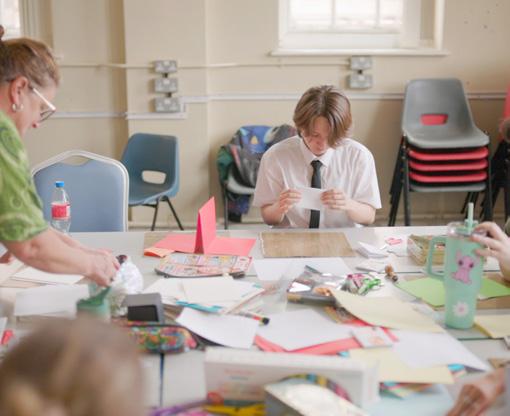
Moving and mental health
Rhiannon Faith Company (RFC) works nationally and locally to create socially engaged dance theatre that promotes community belonging and improves mental health outcomes. The dance company is based at Harlow Playhouse in the south-west of the county and delivers creative interventions that serve as first-line support for community wellbeing, particularly reaching those traditionally underserved by cultural activities.
The company’s Care House Project exemplifies their approach to creative health intervention. Working in partnership with Harlow Playhouse and supported by Arts Council England, National Lottery Community Fund, and Essex County Council Arts and Cultural fund, the project combines creative workshops, performance, and community festival activities to address loneliness and isolation.
In summer 2022, the project delivered six free creative workshops exploring themes through dance and creative writing, followed by ‘care cafes’ supported by a professional counsellor (an approach that ensures clinically safe involvement for all). The workshops involved 11 participants, eight of whom went on to co-create ‘9 Acts of Care’, a dance theatre show drawing from personal experiences of living with and without care.
“A massive show of care for the people of Harlow,” noted one audience member at the culminating Festival of Care in Harlow Town Park, which engaged over 3,000 audience members and nearly 2,000 participants across 58 performances, workshops, and signposting activities. Two thirds of participants reported increased personal resilience as a result of their involvement in the project.
The success has led to plans for establishing The Care House Project as a permanent offer within Harlow’s new Cultural Quarter, embedding creative health interventions into the community’s infrastructure.
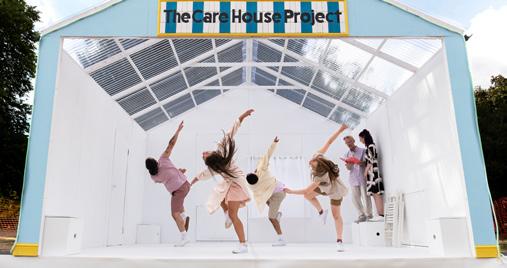
It is important to understand what we mean by creative health, in order to map provision and explore its potential. In December 2023 the National Centre for Creative Health (NCCH) and the All-Party Parliamentary Group on Arts, Health and Wellbeing (APPG AHW) published the Creative Health Review: How Policy can Embrace Creative Health. This report includes definitions, case studies and a call to action for national cross-departmental working. In September 2023 the Culture Health and Wellbeing Alliance (CHWA) published a Creative Health Quality Framework. Both these leading national networks, who play a pivotal role in driving the creative health agenda, adopt the following definition:
The National Centre for Creative Health defines Creative Health as creative approaches and activities which have benefits for our health and wellbeing. Activities can include visual and performing arts, crafts, film, literature, cooking and creative activities in nature, such as gardening; approaches may involve creative and innovative ways to approach health and care services, co-production, education and workforce development. Creative health can be applied in homes, communities, cultural institutions and heritage sites, and healthcare settings. Creative health can contribute to the prevention of ill health, promotion of healthy behaviours, management of long term conditions, and treatment and recovery across the life course.
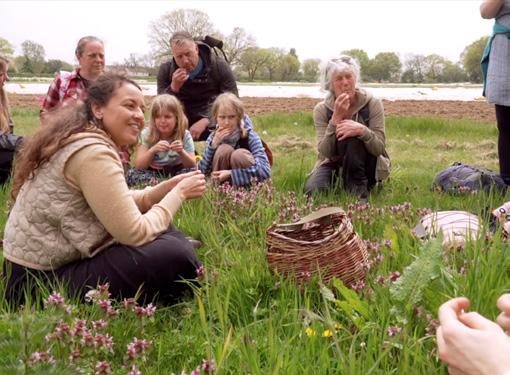
We support the implementation of the above definition as a mechanism to enhance clarity and professionalism across the sector in Essex. We recommend that Essex County Council drives the adoption of this definition across the culture and health sectors. This approach enables the region to be part of the national dialogue and will foster a more collective understanding across delivery, research, and commissioning processes in Essex. We also support the new NCCH Creative Health Toolkit, which was launched in early 2024.
The creative health definition adopted by NCCH and CHWA is deliberately broad to encompass the rich ecosystem of activity. Within this definition, however, it might be useful to start to categorise different ‘types’ of creative health activity. The table below uses a model developed by the Social Biobehavioural Research Group at University College London (UCL) to describe the spectrum of activity within the creative health sector.
Adopted from the Social Biobehavioural Research Group at UCL, the following table and definitions was used as part of our survey to differentiate types of creative health provision.
Arts therapies Targeted therapies in healthcare settings delivered by therapists/ clinicians. Art therapy delivered by NHS or private providers
Arts, heritage and museums work for health outcomes
Arts, heritage and museums learning and out reach programmes
Artists/practitioners and clinicians, working towards a defined clinical aim
Arts, heritage and museum organisations reaching out to specific vulnerable groups in the community
General arts, heritage and museums engagement, which may have the added value of a well being out come
Arts and cultural experiences without health and well being aims
Nationally, creative health has become a strong, effective, and united force. Through recent major developments in the sector now, more than ever, creative health has the potential to help tackle pressing issues across health, social care and public health priorities.
Prevention, early intervention and mental health are key areas for health and social care to fully realise the potential of the arts, culture, and heritage. There are opportunities for embedding creative health in strategic and planned ways to maximise the impact of creative activities and improve health outcomes for the Essex population.
“[cultural interventions] offer something really unique, but the potential of it hasn’t been realised.” (Interview Participant)
The 2024 Creative Health Review – How Policy Can Embrace Creative Health report makes recommendations to the Government and Metropolitan Mayors for a dedicated cross-departmental strategy on creative health. The review gathered evidence and examples of the benefits of creative health, in relation to major current challenges including Mental Health and Wellbeing across the life course; Health Inequalities; Creativity in the Education System; Social Care; End of Life Care, and Bereavement and Recovery from COVID-19. The following key messages arise from the review and echo our local findings and recommendations:
• Creative health is fundamental to a healthy and prosperous society, and its benefits should be available and accessible to all.
• Creative health should form an integral part of a 21st-century health and social care system – one that is holistic, person-centred, and which focuses on reducing inequalities and supporting people to live well for longer.
• Creating the conditions for creative health to flourish requires a joined-up, whole-system approach, incorporating health systems, local authorities, schools, and the cultural and VCSE sectors.
The Culture Health and Wellbeing Alliance (CHWA) Creative Health Quality Framework published in September 2023 provides not only a shared language, but a set of Quality Principles which can be adopted and implemented across Essex. These help to ensure regional practice is in line with national standards and approaches. The Creative Health Quality Framework consists of a set of downloadable PDF resources based around eight Creative Health Quality Principles. It offers clear guidance on how to use these principles to deliver safe and effective projects. The Creative Health Quality principles for good creative health projects are:
1. Person-centred: Value lived experience and enable potential
2. Equitable: Works towards a more just and equitable society
3. Safe: Do no harm, ensure safety, and manage risk
4. Creative: Engage, inspire, and ignite change
5. Collaborative: Work with others to develop joined-up approaches
6. Realistic: Be realistic about what you can achieve
7. Reflective: Reflect, evaluate, and learn
8. Sustainable: Work towards a positive, long-term legacy for people and place
It was noted that sport and physical activity across Essex is now a utilised and well understood tool to address health outcomes in Essex. Active Lives Essex could provide a useful framework to support creative health initiatives to become more strategic across the county.
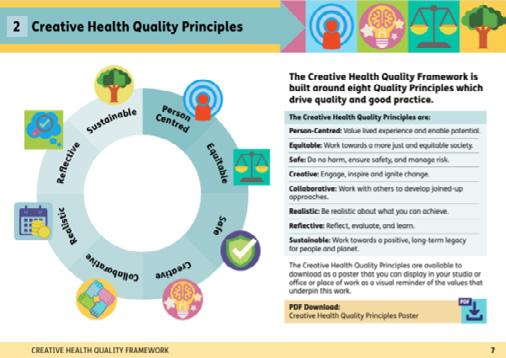
Rigorous evidence that creativity can have a positive impact on health outcomes is comprehensive and growing. There is now a large body of research that consistently shows a positive link between better health and wellbeing and time spent taking part in art, nature, exercise, music, creative, expressive, social, or philosophical activities. The Culture, Health and Wellbeing Alliance (CHWA) has collated the key evidence across the sector on its Research and evaluation (culturehealthandwellbeing.org.uk) webpage. This evidence also shows that these activities can facilitate good health and wellbeing for those with long term physiological or psychological conditions.
The National Academy for Social Prescribing has also created a useful briefing on the use of arts and culture, and suggests creative health can have the biggest impact with: mental health service users; migrants; underserved populations; those who live in deprived areas with less access to community resources, or from low socioeconomic backgrounds; as well as people who re lonely, socially isolated and older adults with cognitive decline (for example problems with memory, reasoning, and language).
The World Health Organisation 2023 report ‘What is the evidence on the role of the arts in improving health and wellbeing? A scoping review’ looked at the results from over 3,000 studies and identified a major role for the arts in the prevention of ill health, promotion of health, and management and treatment of illness across the lifespan. The UK government’s Evidence summary for policy: The role of arts in improving health and wellbeing, found - ‘there is strong evidence that arts can support wellbeing in adults’.
National creative health programmes such as AESOP’s Dance to Health for older people and falls prevention, offer the health system an effective and cost-effective means to address the issue of older people’s falls, reducing falls by 58%.
Led by King’s College London the SHAPER - Scaling-up Health Arts Programmes: Implementation and Effectiveness Research is demonstrating statistically significant evidence that creative health interventions can impact outcomes in reducing postnatal depression, improving motor function, decreasing pain, and improving non-motor symptoms of Parkinson’s and strokes.
The DCMS commissioned review ‘Culture and Heritage Capital: Monetising the impact of culture and heritage on health and wellbeing (2024), found that going to an arts event or taking part in a cultural activity, even only occasionally, has “significant” benefits on health and wellbeing, these include alleviating pain, frailty, depression and dependence on medication. Dr Daisy Fancourt commented on the research concluding; “it suggests that not only could further arts investment be valuable for individuals and the health service as part of a preventative health agenda, but also any cuts to arts funding or provision have to be considered a public health risk with individual and societal economic ramifications”.
https://www.theguardian.com/society/2024/dec/17/consuming-arts-andculture-is-good-for-health-and-wellbeing-research-finds
Community collaborations in culture
Central Saint Martins’ Tendring Initiative is an innovative partnership between University of the Arts London and Tendring District Council. It is designed to harness creative practice for community development in an area where only 22% of residents hold level 2 qualifications, compared to the national average of 38%. The area also has below the national health outcomes, including experiences of poor mental health. The programme focuses on building creative capacity and cultural opportunities in a region where the creative and cultural sector has been historically underrepresented.
Working with local partners and community organisations, Central Saint Martins (CSM) delivers a range of interventions including ‘Making Beyond Words’, a project that brings together local residents and art students to explore creativity through textile-based practices. The programme specifically engages with diverse community groups, including older residents who make up 29% of the local population (compared to 18% nationally), and those from areas experiencing significant deprivation.
“The partnership with Central Saint Martins has opened up new possibilities for our community,” notes a local participant.
“Through creative practice, we’re not just making art – we’re building connections, developing skills, and imagining new futures for Tendring. The presence of art students working alongside local residents has brought fresh energy and perspectives to our area.”
The initiative operates through several interconnected strands:
• Creative skills workshops led by CSM students and staff
• Community engagement through public art projects
• Knowledge exchange between London-based creatives and local practitioners
• Development of shared creative workspaces and resources.
Early evaluation shows promising outcomes for community wellbeing and economic development including:
• Creation of new creative enterprise opportunities
• Increased engagement in cultural activities among local residents
• Enhanced connections between London’s creative sector and Tendring’s communities
• Development of new skills and confidence among participants
“The partnership with Central Saint Martins has opened up new possibilities for our community,” notes a local participant.
This section focuses on the current landscape for creative health in Essex. The information contained in this section is predominately available in the public domain. We have summarised key points for the use of the Essex creative health sector.
ONS Census 2024:
• Essex 1.5 million
• Southend 181k
• Thurrock 176k
Essex is a county in the East of England. It has a population size of 1,503,500. It has a 350-mile coastline and extensive countryside, with key urban city centres. For roads that are designated as country lanes, Essex comes second only to Devon. It is home to Britain’s oldest recorded town, Colchester, founded by the Romans in AD49. Farming is a major part of the Essex economy, growing £400 million worth of produce and employing over 8,000 people in the county. There are over 165 commercial fishing vessels registered in Essex, and every port has its own fleet of charter vessels which take parties of recreational anglers out to the farthest reaches of the Thames Estuary. Essex hosts many areas on the rim of London, earning it a status as a key commuter area.
“Although close, there is a big disconnect with London among communities in Thurrock.” (Survey Respondent)
“Quality of offer decreases as many skilled practitioners are lost to work in London. However, we are close enough that we can benefit from London based skills too. Two way street.” (Survey Respondent)
There are 12 district councils in Essex:
• Basildon
• Braintree
• Brentwood
• Castle Point
• Chelmsford
• Colchester
• Epping Forest
• Harlow
• Maldon
• Rochford
• Tendring
• Uttlesford
• The population in Essex is older than the English average.
• There are 51.3% females, higher than the national average, and 48.7% males, lower than the national average.
• Those born in the UK make up 89.8% of the Essex population, whereas the national average is 82.6%.
• Essex ethnicity is 90.4% white, compared with the national average of 81%, with lower statistics than the national average for all other recorded ethnicities.
• The household being deprived in any dimension sits at 49%, which is slightly higher than the national average of 48.4%, but being deprived in three dimensions is slightly lower at 3.1% compared to 3.7%.
• The socio-economic classification shows Essex has higher levels of people in higher managerial, administrative, and professional occupations than the national average, with significantly lower levels of people who have never worked or are long-term unemployed.
• The economic inactivity rate is 20.4%, which is lower than the national average, and the employment rate is higher than the national average, at 76.8%, with gross median weekly pay also higher than the national average, sitting at £594.
• Essex’s statistics for school attendance, GCSE results in English and Maths, Early Years learning, and overall school performance are consistently within a few percentage points of the national average across all local authorities.
• While obesity prevalence among children in reception and Year 6 is below the national average for local authorities, adult obesity rates exceed the national average.
• The healthy life expectancy (the average number of years a person can expect to live in good health, free from significant illness or disability) for females in Essex is 65.9 years and for males is 64.2 years, both higher than the national average of all local authorities.
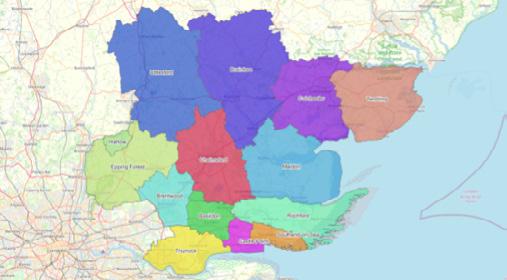
• In metrics for self-reported wellbeing, Essex scored above the national average in feelings of life being worthwhile, happiness, and life satisfaction, while scoring lower in anxiety. All positive aspects were rated at or above 7.5 out of 10.
• In general health, Essex scored higher than the national average with 48.6% reporting very good health.
• There are 16.7% of people recorded as disabled under the Equality Act, compared with the national average of 17.3%.
• Access to digital connectivity is significantly lower than the national average of all local authorities, being at 72.6%compared to 84.6%.
• Travel times to work via bicycle, car, public transport and walking are all higher than the national averages for all local authorities.
The 2022 High-Level Essex Joint Strategic Needs Assessment (JSA) Summary provides an overview of Essex’s health and wellbeing needs, summarising key insights gained from research and health needs assessment to improve health and wellbeing, support evidence-informed decision-making, prioritisation and action to reduce health inequalities effectively. The strategy identifies five key strategic priorities:
1. Improving mental health and wellbeing
2. Physical activity and healthy weight
3. Supporting long-term independence
4. Alcohol and substance misuse
5. Health inequalities and the wider determinants of health
The Essex JSNA highlights significant variations between different areas:
• Life Expectancy: There are notable disparities in life expectancy across Essex. For example, the gap between the most and least deprived areas is approximately 8 years for men and 6.5 years for women.
• Physical activity: While most of Essex is above the national average (47%), just 39.9% of 5 to 16-year-olds in Castle Point are physically active.
• Poor Diet: Less than half of adults in Basildon meet the ‘5-a-day’ recommendation for fruit and vegetables.
• Fuel Poverty: 13.4% of households in Tendring are experiencing fuel poverty, compared to 9.2% in Chelmsford.
These findings highlight the importance of localised strategies to address the unique health challenges faced by different communities within Essex.
The complexity of health and social care provision and commissioning structures plays a large role in how creative health operates across Essex. This complexity is compounded by the Integrated Care Board Structures, which include:
1. Mid and South Essex Integrated Care System
2. Suffolk and North East Essex Integrated Care Board (ICB)
3. Hertfordshire and West Essex Integrated Care system
The Integrated Care System (ICS), governed by the Integrated Care Boards (ICBs) covers different regions to both Public Health boundaries and Arts Council England delivery areas. There is a complex, multi-layered ecology of health commissioners across the region with different responsibilities, properties and governing structures. County Councils have the remit for public health, and additionally there are county NHS priorities. This complex commissioning structure presents challenges as there are varying audiences with different priorities and geographical boundaries to consider. We have included a diagram, Appendix B (see below). We have also provided some information about health structures in Appendix C.

To understand the socio-economic and demographic variations across local authorities in Essex, a clustering analysis was conducted using key indicators derived from 2021 census data. These indicators included population density, education levels, health metrics, deprivation measures, and age distribution, among others. The aim was to group local authorities with similar profiles into clusters, highlighting patterns and trends to support targeted interventions and policy making.

The dataset comprised variations in socio-economic metrics for each local authority compared to the 50th percentile (median). Prior to analysis, all variables were standardised using ‘z-score transformation’ to ensure comparability, as the variables were measured on different scales. Standardisation ensured that no single metric disproportionately influenced the clustering results.
Given the large number of variables, ‘Principal Component Analysis (PCA)’ was used to reduce the dimensionality of the dataset while retaining 90% of the variance. PCA enabled a focus on the most significant components of variation within the data, simplifying the clustering process and improving interpretability without losing key information.
The reduced dataset was analysed using the ‘K-means clustering algorithm’, a widely used method for grouping data based on similarity. The optimal number of clusters was determined using the ‘Elbow Method’, which identifies the point where adding further clusters results in diminishing returns in reducing within-cluster variability. Based on this analysis, four clusters were identified as the most suitable grouping for the dataset.
Each local authority was assigned to one of the four clusters based on its socio-economic and demographic profile. The clusters were then analysed to identify defining characteristics, such as variations in education levels, health outcomes, population density, and economic deprivation. This process revealed distinct patterns, including areas with high educational attainment and low deprivation, as well as areas facing significant health and socio-economic challenges.

A:
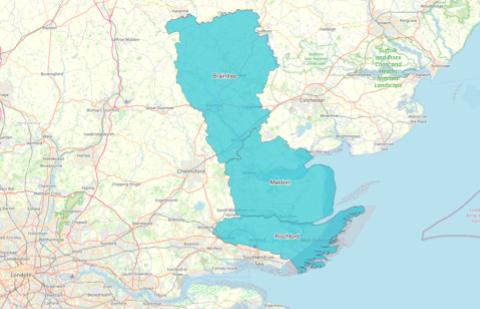
These three Districts share
• Low Density & Low Deprivation: Shows the lowest population density and slightly positive rates for ‘Not Deprived’ areas, but a marked decrease in socio-economic factors.
• High Dependence on Elderly: Higher levels of the 66+ population and dependent children without primary caregivers, but a low presence of multi-family households.
• Educational Attainment and Employment: Low levels of higher education attainment (L4+) and a significant absence of fulltime students.
• Home Ownership: High ownership rates, with moderate social renting.
The potential health priorities for this cluster are:
• Supporting Long-Term Independence: Focus on services for older adults, such as fall prevention programmes, social care support, and initiatives to reduce loneliness.
• Access to Healthcare: Improve access to primary care and specialist services in rural areas through mobile clinics or telehealth solutions.
• Managing Chronic Conditions: Enhance management and prevention of conditions prevalent among older populations, such as diabetes, arthritis, and cardiovascular diseases.

These three Districts share:
• Moderate Density & Lower Deprivation: Higher population density and moderately negative ‘Not Deprived’ score; slight elevation in loneparent families.
• High Younger Demographic: Increased levels of dependent children and fewer elderly, indicating a younger age distribution.
• Moderate Education: Relatively balanced across educational attainment with lower levels of social renting.
The potential health priorities for this cluster are:
• Childhood Health and Wellbeing: Initiatives to address childhood obesity, promote physical activity, and improve mental health services for children and young people.
• Maternal and Infant Health: Programmes to support healthy pregnancies and early childhood development, such as breastfeeding promotion and parenting classes.
• Preventing Mental Health Issues: Early intervention and resiliencebuilding programmes targeting younger populations, including schoolbased mental health support.
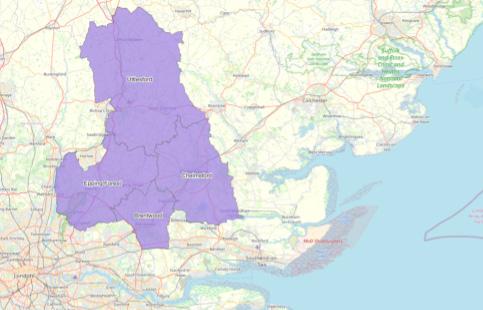
These four Districts share:
• Moderate Density & High Prosperity: Negative variation in density and high positive score for ‘Not Deprived’, indicating a prosperous socioeconomic status.
• Educational Advantage: High L4+ qualification levels, increased presence of full-time students, and higher home ownership.
• Lower Health Issues: Reports low levels of poor health indicators
The potential health priorities for this cluster are:
• Promoting Healthy Lifestyles: Encourage physical activity, healthy eating, and smoking cessation to maintain good health and prevent long-term conditions.
• Preventative Care: Focus on preventative health initiatives, such as regular health checks and screening for cancers and chronic diseases.
• Mental Wellbeing: Despite affluence, address stress and mental health challenges that may arise from high-pressure lifestyles, ensuring access to counselling and support services.
Cluster D: Castle Point and Tendring

These two Districts share:
• Lower Density & High Deprivation: Low density with significantly negative scores in ‘Not Deprived’, suggesting socio-economic challenges.
• High Elderly Population: Highest proportion of the 66+ age group and dependency on social services.
• Low Educational Attainment: Shows the lowest educational qualifications, with a notable increase in fair or bad health indicators.
The potential health priorities for this cluster are :
• Reducing Health Inequalities: Target interventions to improve access to healthcare and address social determinants of health, such as housing and income support.
• Addressing Obesity and Physical Inactivity: Community-based initiatives to encourage healthier eating and increased physical activity, particularly for older adults.
• Substance Misuse and Alcohol Dependency: Support programmes to tackle higher rates of alcohol and substance misuse in deprived areas.
• Improving Access to Mental Health Services: Focus on mental health provision, especially for older adults dealing with isolation and poor mental health.
The table on the following page shows data from the Participation Survey for 2023/24. The right-hand column shows the percentage of the English adult population who said they conducted an activity in the last 12 months. The activities are ranked in order of popularity from high to low.
Each Essex District has its own column. Individual cells are conditionally formatted based on the range of percentages for the activity.
The table allows an analysis of which activities are more popular than average in a place. You can also use it to find the places where engagement in an activity is particularly high.
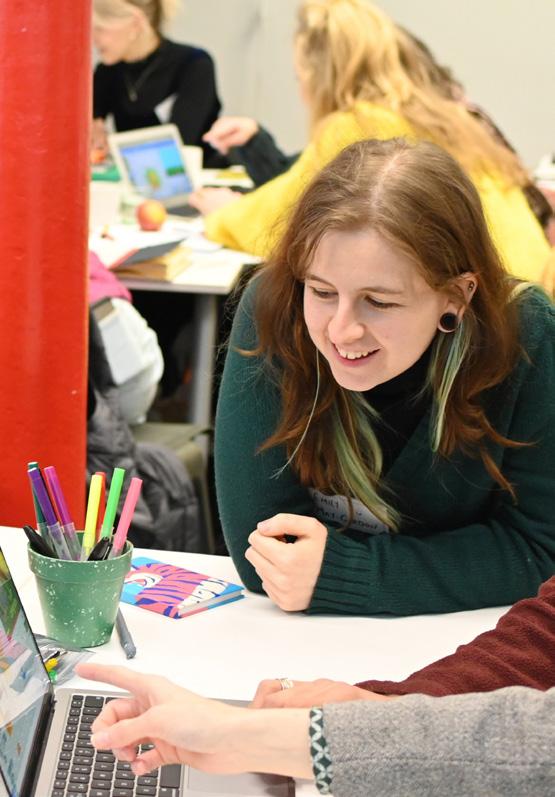
Engaged with arts physically (attended an event or participated in an activity in person) in the last 12 months.
While mapping creative health activity, the project identified both national organisations working in Essex, as well as local grassroots initiatives. For this project, we created categories for the organisations found:
Categories for those involved in creative health provision:
• Creative-health providers (53)
• Community/Volunteer (56)
• Libraries (80)
• Theatres (21)
• Museums/Galleries/Heritage (43)
The creative-health providers specialised in creative health activity in a range of settings. Many community/voluntary organisations use creativity to meet the health needs of their target group. Of course, as described in the limitations section of this report, we have only provided a snapshot of the ongoing activity. Though we did not include all the county’s libraries, theatres, museums, galleries and heritage spaces, our project gives an indication of the creative health activity conducted in these settings. Quite a few collectives exist, linking creatives, like Chelmsford Creative Collective, Creative Colchester and Creative Basildon, with some of the work intending to use creativity for health purposes and some achieving it as a side outcome. Other initiatives such as Made in Essex have the potential for further strategic development across the county.
Creative health organisations often struggle to identify a ‘target audience’ for their work, and many of the companies work with multiple groups, with some having no focus around participants. We therefore focused on the following key Information, gathered through the various methods deployed in this project:
• Organisation/group/company name
• Overview
• Website
• Art form
• Postcode
Further information regarding creative health activity was gathered via the survey responses. There were 45 responses, with a 60% completion rate and a typical time spent of 20 minutes. The most responses came from the Mid and South Essex ICB region. Some key graphs and insights are included below.
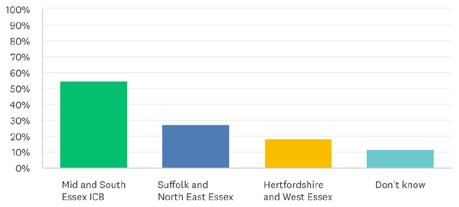
Respondents detailed a broad range of responses for how they primarily describe their organisation, with the most popular being arts organisations and then charity.


Above, you can see the variation in art form, which is very mixed, with strong visual arts and crafts representation, and a broad range of activities for people to engage with.
A wide range of characteristics or groups was prioritised, with the highest responses for older people 65 plus.

There were many answers for how to categorise creative health activity and projects, with some other suggested responses including ‘creativity for health outcome’, ‘social group’, and ‘community-led general arts’.
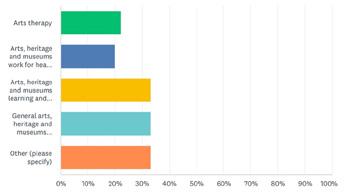
Respondents mostly deliver their work in community settings.

There was a slight focus on mental health and wellbeing.

Charities and community organisations commissioned the most work.

Less than a quarter of organisations’ income currently comes from creative health activity, yet organisations wish to increase their creative health delivery.

What are the current evaluation processes used for your Creative Health projects and how useful do you find it?
If you are a commissioner, please select what you would like to see?
Internally designed monitoring and evaluation processes
Theory of change/logic modelling
Outcome frameworks (e.g. outcome star model etc)
Warwick-Edinburgh Mental Wellbeing Scale - WEMWBS
Wellbeing
In summary, most of the creative health activity mapped was in the Mid and South Essex ICS regional area, the largest of the three ICS in the county. Of the 45 respondents, the majority identified themselves as arts organisations or charities. We found a wide variation in art form, with strong representation from visual arts and crafts. A wide range of target groups were reached, with the highest response rate for older people 65 plus, again matching the population needs. creative health is mostly delivered in community settings, but activity does take place in health and cultural settings too.
Groups found it hard to categorise their activity, which could be an area for development amongst the creative health providers to enable more targeted interventions to meet specific health outcomes. Creative health providers predominantly focus on mental health outcomes, which does correlate with the needs of the county and the growing evidence base that creativity can support improved mental health. The survey also highlights that most creative health organisations received less than 25% of their funding from creative health initiatives.
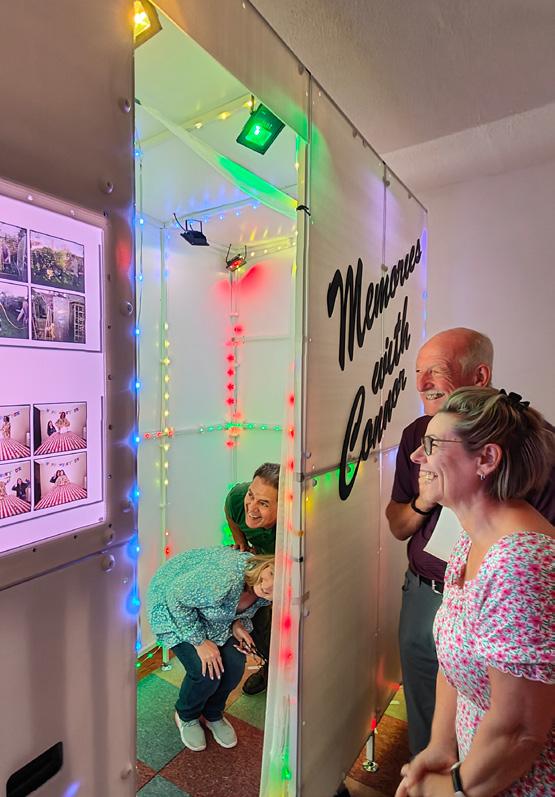
Geographical Distribution - where are creative health initiatives concentrated within Essex
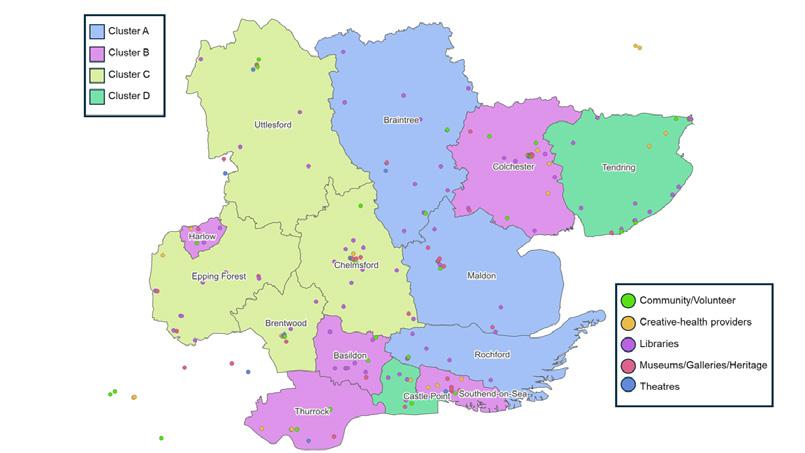
Saffron Hall, a world-class concert venue, is pioneering a unique model of cultural provision that demonstrates a significant impact on community wellbeing through its innovative dual-use as both a music venue, and a school and community venue. Located on the campus of Saffron Walden County High School in the west of Essex, the Hall delivers wide-ranging community and educational programmes that support mental health and wellbeing across Uttlesford and beyond.
The Hall’s approach combines professional performances with extensive community engagement through various initiatives. A flagship programme is ‘Together in Sound’, a music therapy project specifically designed for people living with dementia and their companions. The Hall also runs ‘Come Together’, an intergenerational creative community project that bridges age gaps and reduces social isolation.
These programmes are delivered alongside performances, open rehearsals, side-by-side workshops, and masterclasses that engage both primary and secondary school students.
A recent impact evaluation demonstrates significant wellbeing outcomes across multiple stakeholder groups, with the total wellbeing impact of the hall’s work on volunteers, schools, community participants, and amateur performers valued at £775,000. The Learning and Participation programme alone generated wellbeing benefits worth £362,000, while amateur performers experienced wellbeing impacts valued at nearly £350,000.
A comprehensive audience survey revealed that 60% of respondents reported Saffron Hall had a critical or significant impact on their health and wellbeing. The Hall’s influence extends beyond individual benefits, with 55% of respondents indicating it has a critical or significant impact on the general wellbeing of the local community.

Through the mapping, interviews and focus groups, we have found a range of opportunities in creative health across Essex. These include:
The power of the community
• Strong Local Leadership and Hubs: Essex benefits from strong local leadership and numerous local hubs with vibrant cultural scenes. These hubs foster community connections and support creative health initiatives.
• Community Knowledge and Passion: Local knowledge, pride, and passion for creativity drive the success of creative health initiatives, reflecting a strong sense of community and commitment to positive change.
• Collaborative Spirit and Supportive Partnerships: There is a genuine appetite among creative health professionals to collaborate, share best practices, and support each other. Open conversations and partnerships, especially with venues and the County Council, are effective once trust is established.
• Strong Volunteer Sector: A robust volunteer network supports creative and cultural initiatives, adding energy and capacity to the sector.
• Diverse Population and Representation: Essex’s diverse demographic provides opportunities for creative activities to foster pride, representation, and resilience across different communities.
• Creative Health as a Leveller: Creative health activities engage diverse populations, making them inclusive and effective in reaching those not typically involved in traditional health interventions.
• Opportunities for Older and Younger Populations: Older adults benefit from cultural activities that keep their minds active and promote social engagement. Younger people gain from programmes that enhance literacy, creativity, and social development.
• There were barriers around inclusion and diversity too, as respondents reported: “It was noted that we weren’t from the area and some artists weren’t too happy about that which we fully respect” (Focus Group Participant, 13.06.24); “To be inclusive to everybody all the time and be everything to everyone. It’s really difficult to do that” (Focus Group Participant, 13.06.24)
• Positive Impact of Tailored Creative Activities: Tailored creative activities improve physical and mental wellbeing, potentially reducing costs in adult social care. Participation in creative activities is linked to relaxation, mental stimulation, and overall satisfaction.
• Addressing Loneliness and Social Isolation: Creative health activities foster a sense of belonging and encourage participation, particularly for isolated individuals, including older adults.
• Creative Health and Regional Disparities: Programmes in deprived areas demonstrate the potential of creative health to reduce regional health disparities and improve outcomes.
• Integration with Social Prescribing: Increasing use of creative health initiatives in social prescribing links individuals to creative activities for mental health and wellbeing, ensuring doctors recognise their value.
• Arts and Culture as a Catalyst for Civic Pride: Creative health initiatives can enhance civic pride, which contributes to better health outcomes and community resilience. “One of the greatest things [culture] can do from a health perspective is build civic pride.” (Interview Participant)
• Tourism and Economic Growth: Arts and culture boost Essex’s tourism and economic growth by creating a unique local identity and providing affordable, high-quality cultural offerings as alternatives to London venues.
• Proximity to London: Essex’s close relationship with London provides opportunities for upskilling, sharing artists and participants, and accessing additional resources. Also national organisations such as Magic Me, Orchestras Live, Metal and Live Music Now provide opportunities for scaling and skills development.
Magic Me exists to bring the generations together as equals through the arts to build more integrated and resilient communities. They deliver a range of work in Essex to improve health ouctomes. They have established partnerships with accademic instututions to drive research and improve practice.
https://magicme.co.uk/
• Support for Creative Venues and Programmes: Affordable and welcoming venues play a key role in supporting recovery and creative activities. Informal, low-pressure spaces encourage social engagement and wellbeing.
• Optimism and Momentum: There is significant positivity around this project and the future of the creative health sector, with recognition of its potential to drive meaningful change.
• Amplifying Local Creativity: Leveraging local creativity not only fosters pride and resilience but also creates new opportunities for growth within the sector.
• A need for Countywide Leadership: Whilst we found local strategic development, countywide strategic partnerships could enhance development and growth.
CoDa is an award-winning, socially driven, female- & disability-led dance company, delivering participatory projects in hospitals and communities. CoDa works with neuro-disabled people and their support networks to create immersive and interactive dance experiences and performances that get people moving, and challenge perceptions of difference and disability. They are currently leading on good practice to support healthcare staff and families develop innovative ways of working.
https://codadance.com/

The research also found a range of challenges related to the national and local backdrop, economics and geography.
“[Cultural interventions] offer something really unique, but the potential of it hasn’t been realised.” (Interview participant)
1. Funding and Sustainability
• Inconsistent and Short-Term Funding: Budget cuts and short-term funding cycles hinder long-term project sustainability. Reduction in funding opportunities and reliance on temporary grants leave initiatives vulnerable to cuts.
• Barriers to Accessing Funding: Challenges include meeting funders’ expectations, preparing time-intensive applications, and confusion around being ‘commissioning ready’ versus ‘grant ready’. Increased competition for funding leads to underpricing and a focus on new initiatives, leaving existing programmes under-supported.
“A challenge that will present for creative health programs is actually for that continuation of funding, and for the kind of longer medium to longer term funding.” (Focus Group Participant)
• Cost of Delivery: Creative health projects can be expensive per head to achieve meaningful outcomes, especially in underserved communities. High venue hire fees in town centres further strain budgets. “Some projects are expensive per head in order to achieve meaningful outcomes. It is not easy securing funding for these, and then continued support for sustained activity.”
• Transport Limitations: Poor public transport networks and infrastructure, particularly in rural and coastal areas, limit access to cultural activities and make collaboration among professionals challenging. Transport costs and infrequent services disproportionately affect underserved communities.
• Regional Disparities: Essex’s size and socio-economic diversity create significant health and cultural gaps, with deprived areas like Jaywick facing greater challenges. A ‘one-size-fits-all’ approach is ineffective due to differing needs across urban, rural, and coastal areas.
• Proximity to London: While close to London, Essex faces challenges such as higher costs, competition from London-based organisations, and a ‘talent drain’ of creatives relocating to the capital.
• Cultural Stereotypes: Negative stereotypes about Essex can overshadow its rich creative potential, leading to reduced external recognition.
• Perception of Arts as ‘Highbrow’: Cultural activities such as opera or classical music are often perceived as intimidating or exclusive, deterring participation. Arts and creative health are sometimes seen as a ‘nice-tohave’ rather than essential to health and wellbeing.
• Visibility and Marketing: Small, local initiatives lack visibility, particularly without strong digital or social media presence. Communication gaps between cultural and health sectors limit awareness of available opportunities.
“I think we got just enough people to run it the first time [but] we could have done with a few extra people.” (Interview Participant)
• Reliance on Volunteers: Many initiatives depend on volunteers or the passion of staff to deliver creative activities, creating inconsistencies and vulnerability.
• Burnout and Organisational Capacity: High demand and frequent changes lead to burnout among practitioners. Limited capacity to manage increased workloads strains existing resources.
“There are a lot of artists wanting to do this work but that don’t have even a very basic understanding of what’s needed to work with people living with mental health conditions.” (Interview Participant)
• Training and Health Professional Engagement: Limited training for health professionals reduces their engagement in creative health initiatives. There is a lack of understanding within local health boards about the value of creative health in preventing and addressing health issues.
• Cost and Accessibility: High costs of participation can exclude those who would benefit most from creative health activities. Infrequent or inaccessible transport further exacerbates inequality, particularly in rural areas.
“Due to a lack of transport people often cannot access our locations or have to rely on schools and social services to organise transport to our programmes which can often be costly and unreliable.” (Survey Respondent)
• Digital Divide: Older adults and underserved communities face challenges accessing digital resources, limiting their ability to engage in virtual creative health opportunities. Underserved Communities: Communities most in need of creative health interventions often face the greatest barriers to access, due to transport, cost, and limited local infrastructure.
“Poor transport and infrastructure can present a barrier to access for communities, often those who could benefit most.” (Survey Respondent)
• Lack of Countywide Integration: Essex lacks an overarching strategy to integrate creative health initiatives across its diverse regions.
• Communication Gaps: Poor communication and collaboration between cultural and health sectors limit opportunities to share best practices and resources. Integration Challenges: Difficulty incorporating creativity into prescriptive health systems, such as social prescribing, limits its potential.
• Untapped Preventative Potential: The role of creative health in preventing health issues remains underappreciated, with cultural initiatives often sidelined during acute health crises.
“Things are fragile, but in the last five years, they have changed beyond recognition […] so it feels like the time is right.” (Interview participant)
• Competition and Demand: Increased demand for mental health services intensifies competition for resources. Tenders are often too specific, narrowing the pool of eligible organisations.
• Local vs. External Providers: Essex organisations face competition from London-based companies, which sometimes win funding at the expense of local creatives.
We also explored specific creative health sector training and development needs, and found both cross cutting themes with the opportunities and challenges above, and new emerging issues. These include:
• Diversity and Accessibility: Ensuring creative health activities are customer-led can enhance access for diverse groups. Physical access and affordability remain significant challenges, particularly in rural or underserved areas. Funding constraints can limit the ability to fully address diversity and accessibility needs.
• Tailored Approaches: Building relationships and co-producing initiatives with participants ensures cultural activities are relevant and inclusive, but short-term projects often hinder these efforts. Local communities thrive when they can lead and shape cultural activities without excessive bureaucracy.
• Youth Engagement: Broadening the definition of culture (e.g., including computer games or community music) can help reach younger populations who may struggle with traditional subjects.
• Marginalised Groups: Ensuring existing programmes are accessible to marginalised and underserved groups is critical. Subsidised costs and broader outreach could lower barriers for families and other disadvantaged demographics.
• Training Gaps: Training is needed for facilitators in areas such as mental health first aid and working with vulnerable groups; navigating specific creative health settings and understanding health sector terminology; bid/tender writing and commissioning creative health projects; building partnerships and highlighting the benefits of creative health.
• Ongoing Training: Regular refreshers, such as first aid updates and new skills development, are crucial to maintain safety and quality.
• Artists in Health Contexts: Many artists are interested in working in health and wellbeing but lack the necessary skills and understanding. Training programmes about working in health contexts could help bridge this gap.
• Workforce Development: Aligning creative health initiatives with workforce development priorities in health and social care could attract greater interest and funding.
• Partnership Building: Partnering with health professionals, councils, and community leaders is essential for scaling and sustaining creative health initiatives. Cross-sector collaboration between arts, health, and social care remains underdeveloped and requires greater coordination.
• Leadership in Health Sector Conversations: Cultural leaders need a stronger presence in health discussions to advocate for the inclusion of arts in public health strategies. Universities and councils should connect with local communities to foster creative expression and social mobility.
• Social Prescribing: Social prescribing is a promising mechanism for creative health but lacks cohesion and consistency. Strengthening it could provide accessible pathways to health-focused cultural activities.
• Structural Shifts: Preventive creative health investments remain scarce. Shifting public health priorities to incorporate culture and creativity could direct resources to communities most in need. Integrating creative health into broader public health policies would strengthen its role in health improvement.
• Evidence-Based Advocacy: Stakeholders need data-backed evidence of social, health, and economic returns to support funding arguments and long-term investment in creative health. Despite its impact, culture has not yet achieved the influence in health conversations that sport enjoys. Highlighting success stories can help shift perceptions.
• Sustaining Local Initiatives: Long-term sustainability requires significant support and buy-in from local stakeholders. Building trust within tight-knit communities requires persistence and sensitivity.
• Avoiding Bureaucracy: Local community knowledge and leadership are strengths but are often unsupported. Efforts to scale creative health should avoid adding excessive bureaucratic barriers.
• Promoting Local Offerings: Essex boasts a wide range of cultural organisations, from grassroots groups to National Portfolio Organisations (NPOs), but a more cohesive approach to promotion is needed to enhance public engagement. Greater visibility and connectivity across programmes would boost participation without adding unnecessary administrative layers.
• Engaging Communities: Authorities and organisations must improve outreach to underserved populations, ensuring their cultural and health needs are met. Pairing local residents with artists has proven effective in nurturing personal growth and fostering connections.
• University Engagement: Universities, such as the University of Essex, must strengthen ties with local communities by addressing barriers like high fees, cost of living, and institutional mistrust.
• Learning from Sport England: Sport England’s success in advocating for preventive health funding offers a model for the arts. Scaling projects like Basildon’s cultural partnership could bridge regional health gaps and create creative health ecosystems tailored to local needs.
• Strengthening Ecosystems: Initiatives should aim to connect various forms of creative expression, offering pathways for individuals to explore a wide range of cultural activities.
• Co-Production at the Core: Co-production should be central to creative health development, ensuring that local voices shape the future of the sector.
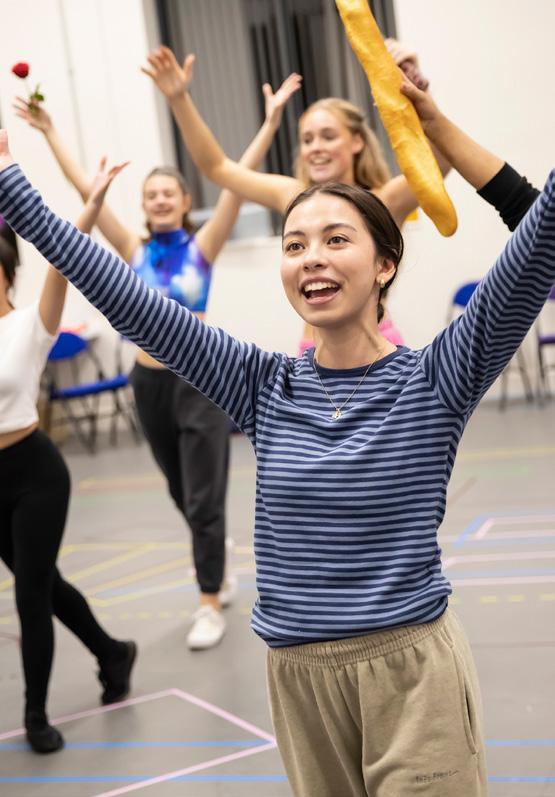
Reading for the future
Essex Book Festival’s Young Readers Programme is a county-wide initiative that uses literature and creative writing to support youth mental health and wellbeing across Essex’s diverse communities. Operating as Essex’s only county-wide multi-venue literary festival, the programme specifically targets young people through innovative literary experiences that promote reading for pleasure, creative expression, and emotional resilience.
The festival works in partnership with libraries, schools, universities, and health services to deliver year-round programming that combines author visits, creative writing workshops, and reading groups. Through its ‘Golden Age’ theme, the festival creates intergenerational connections while addressing contemporary challenges facing young people, including mental health, social isolation, and environmental concerns.
Key initiatives include:
• Pop-Up Creative Writing Workshops in schools and community settings
• Essex Young Writers development programme
• Reading for Wellbeing sessions in partnership with libraries
• Digital storytelling projects connecting urban and rural youth
• Environmental writing workshops exploring eco-anxiety and climate action
The programme’s impact demonstrates significant outcomes for youth wellbeing and engagement, including:
• Increased participation in reading and creative writing activities among young people
• Development of peer support networks through shared literary experiences
• Enhanced confidence and self-expression among participants
• Strengthened connections between generations through storytelling
A key initiative that has emerged from the Essex Book Festival is the Manifesto for Essex - a forum and ongoing series of events connecting young people and forging new ideas and approaches to environmental challenges facing the county and its young residents.

Opportunities in creative health in Essex lie in leveraging its strong local leadership, vibrant cultural hubs, and passionate communities to drive impactful initiatives. The county’s collaborative spirit and robust volunteer sector provide the foundation for inclusive creative health programmes that engage diverse populations, addressing social isolation, fostering civic pride, and reducing regional health disparities.
Tailored creative activities improve mental and physical wellbeing, with benefits for older adults, young people, and underserved communities, while integrating effectively into social prescribing. Essex’s proximity to London enhances resource-sharing and growth opportunities, while its arts and culture scene boosts tourism and economic vitality. Optimism and momentum behind the sector can solidify Essex’s role as a leader in creative health, fostering resilience and driving positive change.


1. Adopt and implement the CHWA Creative Health Quality Framework and the definition of creative health across Essex: Aligns regional practice with national standards, leveraging strong local leadership and fostering collaboration.
2. Build on regional and local strength and excellence to establish ‘Creative Health Action Zones’: Enhances civic pride and creates spaces for needs based, community-driven creative health activities.
3. Foster collaborative working to provide opportunities and support for scaling activity: Amplifies existing creative health programmes, boosting their reach and impact.
Challenges and barriers to creative health in Essex highlight systemic issues limiting the sector’s potential. Inconsistent funding, high delivery costs, and difficulty accessing grants undermine project sustainability, while regional disparities and poor transport networks exacerbate inequities, particularly in rural and deprived areas. Negative stereotypes about Essex, perceptions of the arts as exclusive, and a lack of visibility hinder broader engagement. Capacity issues, reliance on volunteers, and practitioner burnout strain resources, while limited training and health professional buy-in restrict integration with health services.
Accessibility challenges, including high participation costs, transport limitations, and the digital divide, further marginalise underserved communities. Structural barriers, such as weak countywide integration and poor communication between cultural and health sectors, stymie collaboration and innovation. Additionally, competition with Londonbased organisations and narrowly defined funding opportunities place local creatives at a disadvantage, leaving Essex’s rich creative potential underutilised.

4. Build a high-level partnership between Essex County Council, Essex health and Wellbeing Board, Integrated Care Boards, regional NHS and Public Health bodies: Embeds creative health into strategic health initiatives, addressing gaps in collaboration and integration.
5. Improve strategic connections to develop longer-term funding opportunities and resource allocation for sustainability: Tackles the challenge of short-term, inconsistent funding that undermines project longevity.

6. Through partnership working, enhance the quality and consistency of evaluation methods across creative health activity in Essex: Provides evidence of impact to secure funding and improve programmes, addressing perceptions of arts as ‘non-essential’.
7. Create a shareable and editable list of potential commissioners of the work: Simplifies access to funding and collaboration opportunities for local organisations.
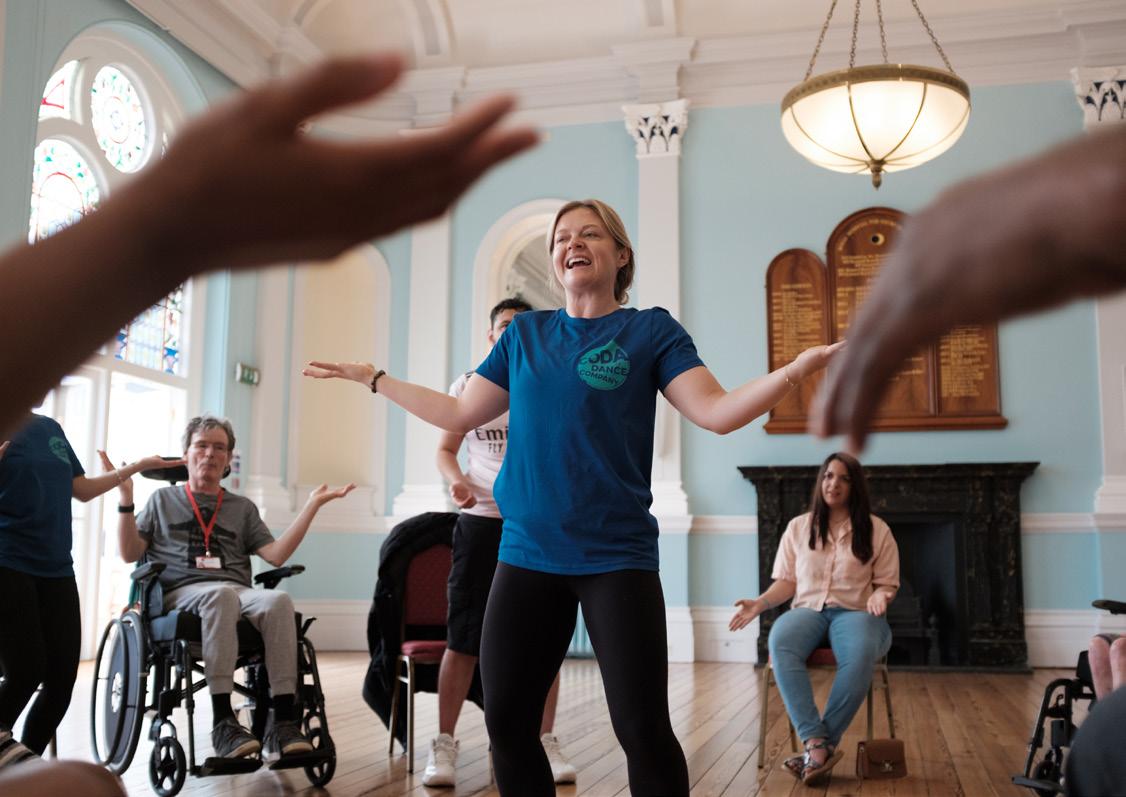
8. Build on the work of local Creative Hubs in Essex: Create Hubs could cascade creative health information and evidence: Improves visibility and communication, reducing fragmentation in the sector.
9. Advocate for better transport networks, by linking with other relevant campaigns to improve access to creative health initiatives, particularly in rural areas: Addresses transport limitations that prevent participation in underserved communities.
The future scaling and sustainability of creative health in Essex depends on fostering diversity, access, and inclusion while addressing systemic gaps in skills, training, and cross-sector collaboration. Tailored, communityled approaches are essential to ensure cultural activities meet the needs of underserved and marginalised groups, particularly youth and disadvantaged populations. Training facilitators in mental health, bid writing, and partnership-building can empower artists to work effectively in health contexts.
Long-term sustainability requires structural shifts, such as integrating creative health into public health policies, strengthening social prescribing, and securing evidence-based advocacy to demonstrate impact. Collaboration between cultural, health, and social care sectors is critical, as is promoting local offerings to boost visibility and engagement. To scale initiatives successfully, Essex must leverage models like Sport England, strengthen creative ecosystems, and prioritise co-production to ensure local voices shape the sector’s future while avoiding excessive bureaucracy.

10. Focus on joint commissioning, training, and skills development that brings health and culture professionals together: Equips practitioners with the tools needed for impactful work and strengthens cross-sector collaboration. Facilitates knowledge exchange and training opportunities to strengthen the creative health workforce.

11. Fostering partnerships between artists, local authorities, health professionals, and researchers, with network opportunities at a strategic level: Improves knowledge of local health needs and builds capacity and enhances collaboration to support creative health initiatives.
12. Support organisations and creative practitioners to enhance their offer to diverse groups and volunteers: Strengthens inclusivity and builds practitioner capacity to work with diverse communities.
Resulting from a partnership between Live Music Now, Parents1st, and B3, the Lullaby Project is a programme of activities designed to improve maternal and child health and wellbeing during the critical perinatal period.
By pairing musicians with mothers over a series of 1-2-1 and group sessions, the project allows musicians to support mothers through the process of composing and recording their own personal lullabies for their babies. While navigating the creative process of music-making, mothers are also encouraged to explore their own emotions and hopes for the future. This therapeutic approach not only helps improve mental health and emotional wellbeing among mothers, but also strengthens the bond between mother and child.
Once recorded, the songs are then shared with families and the wider community in a series of celebration events. These events highlight the power of music and personal expression
In fostering maternal and child wellbeing, while also creating lasting connections between mothers, families, and their communities.
Project Aims:
1. To improve maternal and child health during the perinatal period.
2. To enhance mental health and emotional wellbeing for mothers through creative expression.
3. To provide mothers with increased access to services and support systems.
1. Increased emotional connection and bonding between mothers and their babies.
2. Improved mental health and emotional wellbeing for participating mothers.
3. Strengthened community connections through celebration events showcasing the lullabies.
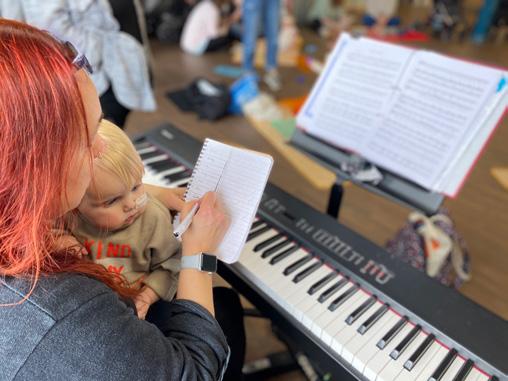
This report underscores the vital role creative health could be playing in addressing key health and wellbeing priorities across Essex. Building on the Essex County Council Cultural Strategy, which highlights the transformative power of arts and culture, this study reveals a sector with significant potential to enhance quality of life for individuals and communities. By mapping current provision, identifying challenges, and exploring opportunities, the report provides a roadmap for harnessing creativity as an essential component of health and social care.
The findings demonstrate that Essex benefits from a vibrant creative health landscape, bolstered by strong community leadership, collaborative partnerships, and a rich diversity of cultural activities. However, challenges such as inconsistent funding, geographic inequalities, and gaps in skills and training must be addressed to fully realise the sector’s potential. Moreover, the absence of a unified framework for good practice, and limited data on outcomes, hinder the ability to advocate for sustained investment and scale up successful initiatives.
To overcome these barriers and maximise opportunities, the report recommends adopting the Culture, Health and Wellbeing Alliance’s Creative Health Quality Framework, fostering cross-sector collaboration, and prioritising long-term funding and resource allocation. Strategic partnerships between Essex County Council, the NHS, and Public Health bodies are essential to integrating creative health into broader health strategies and securing its role in prevention, care, and community resilience. Furthermore, investment in skills development, inclusive programming, and evidencebased advocacy will empower practitioners to deliver impactful, sustainable initiatives that address the diverse needs of Essex’s communities.
As the national momentum behind creative health grows, Essex is wellpositioned to lead by example, demonstrating how culture and creativity can drive meaningful change. By embracing this opportunity, Essex can not only improve health and wellbeing outcomes but also foster a more inclusive, vibrant, and connected society. This report provides a foundation for action, urging stakeholders to unite behind a shared vision that places creativity at the heart of community and individual wellbeing.
Creative Lives is doing a deep dive into the Tendring District Council region, a coastal area in Essex facing multiple challenges. Tendring District Council has recognised the valuable contribution the creative sector can have in tackling not only economic and social outcomes, but health and wellbeing outcomes too. In 2019 they produced the first Tendring Creative and Cultural Strategy 2019 - 2024 in partnership with Arts Council England. The strategy states: ‘Wellbeing statistics are concerning, with significant indicators of poor mortality, morbidity and mental health and [the strategy] seeks to drive participation, jobs and innovation through the creative and cultural sector.
Through our research, so far, we have found a huge range of creative activities in Tendring, delivering activities that seek to reduce social isolation and tackle poor mental health. These range from libraries delivering poetry and ukulele groups, to pop-up craft sessions (with a focus on sustainability), camera clubs and theatre groups, as well as the partnership with Central St Martins mentioned in the case study above. So far we have mapped over 38 groups, including singing, ballroom and knitting groups. For example the Brightlingsea WinterFest, led by volunteers to tackle mental health issues during the winter months. ‘WinterFest helps to fight depression by raising spirits and developing a sense of community during the darkest time of the year. It’s a serious subject, but we have a lot of fun with a host of music, arts and other events’.
It is also worth noting that with funding from Arts Council England, the Tendring Cultural Education Partnership has engaged with children and young people across Tendring to co-design the Tendring Youth Voice Project. The resulting film ‘Don’t change my Vision’ highlights the importance of culture and creativity to young people and the impact participation has on wellbeing and mental health. 93% of young people engaged stated that culture and creativity is very important to them.
Brightlingsea WinterFest - Brightlingsea WinterFest
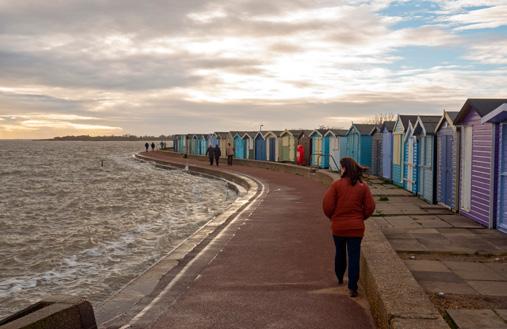
A: Methodology Continued
The focus groups took place over three consecutive days in June 2024. The first day consisted of an hour-and-a-half morning session in person at the Essex Record Office in Chelmsford. Over the next two days, a morning and then an afternoon session took place online each day, lasting one hour each session.
The sessions were advertised via public channels, and participation was completely voluntary. Participants registered their interest in attending the different sessions through an online booking system. Though interested participants could attend any session, there was a focus on creative health providers at the in-person session, researchers on the first day of online sessions, and health professionals on the final day.
We emphasised that other opportunities exist to contribute to the work if people cannot attend the planned sessions, including 1-2-1 interviews, an online survey, and the possibility of further networking sessions.
Participants’ demographic details were not collected before the focus groups since we aimed to gather qualitative insights on creative health irrespective of participant demographics. A diversity monitoring form was distributed after the completed focus groups to monitor engagement.
The in-person focus group had sixteen attendees. On the first day of online sessions, there were six attendees in the morning and twelve in the afternoon. The second and final day of online focus groups saw eight attendees in the morning and five in the afternoon.
Consent forms and information sheets were distributed to ensure informed consent regarding the participant’s involvement in the focus group and how any materials would be used following the session. Notes were taken to capture key points and insights, as well as video and audio recordings.
Damian Hebron was the Lead Facilitator for the focus groups, supported by the Project Manager, Jess Plant, and the Lead Researcher, Natasha Richards-Crisp. A workshop plan was used to guide the in-person focus group, and an outline guide was given via slides for the online sessions, both of which are included for reference in the appendix. However, we were open to the discussion being led by the participants, remaining responsive to the conversations within the room.
The following documents were produced and are available on request:
• Participant Information Sheet
• Participant Consent Form
• Workshop Plan for In-Person Focus Group
• Creative Map for In-Person Focus Group
• Online Focus Groups’ Slides
The interviews took place over Zoom during the period of SeptemberNovember 2024. Eight interviews were conducted during this time. They were recorded and lasted around 30 minutes.
The interviewees were approached by Creative Lives to participate in the interviews due to their various roles in the field of creative health. Interviewees’ demographic details were not collected before the interviews since we aimed to gather qualitative insights on creative health irrespective of interviewees’ demographics. Participation was entirely voluntary.
For consent and ethical procedures, the following information was detailed to interviewees vocally by the interviewer at the start of the interview:
“Before we begin, I want to inform you that this interview is part of Creative Lives’ commission with Essex County Council to map the current cultural health activities in Essex. By participating in this interview, you are agreeing to allow your responses to be recorded and used as part of this project. Your participation is completely voluntary, and you may choose to skip any questions or stop the interview at any time. If you have any concerns or would like to withdraw your consent at a later date, please feel free to contact me. Do you agree to proceed under these terms?”
Three members of the project team conducted the interviews: Lead Facilitator Damian Hebron, Project Manager Jess Plant, and Lead Researcher Natasha Richards-Crisp. We utilised open conversations, based on semi-structured interview techniques, as a qualitative research method allowing in-depth exploration of a subject by encouraging interviewees to share their experiences, opinions, and thoughts freely.
Additionally, the following questions were devised as a guide if helpful for the conversation:
1. What are the greatest health needs in Essex and where can we find the best evidence of this? (priority health issues and areas/groups in greatest need)
2. What impact could creative activity have on health needs in Essex?
3. What activity is currently being delivered in the creative health sector across Essex, and how is it funded, reviewed, and sustained?
4. What does good practice look like in creative health, and how can it be defined, shared, and potentially scaled up?
5. Can you see any issues/problems/challenges with the creative health sector and how it interfaces with health services?
6. Where are the commissioning opportunities/other funding available?
7. What are the mechanisms/pathways through which to deliver creative activity?
8. What are the workforce and volunteer needs regarding support and skills development?
9. How can we strengthen the case for creative health in the region, and what strategic levers can be drawn to ensure future investment?
10. Other ideas/interests/opportunities
From our learnings from the focus groups, we also identified the following key themes as a further guide for the conversations:
• Health needs
• Benefits of creative health
• Challenges to creative health
• Training
• Funding
• Infrastructure
• Sustainability
• Access
• Community
• Communication
The interviewer wrote reflective notes immediately after the interview to capture thoughts, impressions, and initial analysis. These notes were then further analysed by summarising three key themes from each interview. All interview summaries were then reviewed alongside each other to identify common themes, insights and recommendations.
The survey was designed on Survey Monkey. It took an estimated 25 minutes to complete. An example of the survey is included as an appendix to this report summary.
By completing the survey, participants could win a £100 gift voucher. By submitting answers in the survey, participants permitted Creative Lives to store their data on the Mapping database as part of the research project. Any answers submitted in this survey will remain anonymous in the report unless, in special circumstances, Creative Lives directly asks for participants’ permission on the contrary.
B: ICB Structure Diagram

During focus group sessions people asked for clarity about what commissioning is, who commissions NHS services, and for help with some of the NHS acronyms and terms. The move away from transactional models, towards greater partnership working means the commissioning landscape is complex. Relationships are changing, here is a very simplified overview as at January 2024:
NHS England
• leads the NHS in England to deliver high-quality services for all
• supports programme teams and seven regional teams
• corporate functions e.g governance and legal, HR, estates, corporate IT and internal strategy
• may directly commission programmes and specialised services
NHS England — East of England
• the NHS regional team for the geographic area Norfolk and Suffolk sits within.
• responsible for the quality, financial and operational performance of all NHS organisations in their region.
• supports the identity and development of integrated care systems.
• directly commissions armed forces, Health & Justice, Public Health screening programmes and specialised services. Some of these responsibilities will be delegated to ICBs over the next 12-24 months.
Integrated Care System (ICS)
Each Integrated Care System comprises of two elements:
Integrated Care Board (ICB)
• Plans and commissions NHS services, including ambulances, primary care, mental healthcare, hospital (acute), community and specialist care.
• Decision making linked to and informed by the wider Integrated Care Partnership.
• A statutory committee of partner organisations who all have a role in improving local health, care and wellbeing.
• Includes Local Authorities, third sector, care providers and other key partners.
• broader focus, covering public health, social care and wider issues impacting the health and wellbeing of local populations.
Healthwatch
• Healthwatch is the UK’s independent consumer champion for health and social care.
• Operates at national and local level to listen to views and experiences.
• Aims to ensure that voices of people who use health and social care services are heard. Healthwatch gathers feedback from the public, investigates concerns, and works to improve the quality of health and social care services by influencing policy and practice.
• Funded in part by government (Department for Health and Social Care), Healthwatch also pitches for work commissioned by others.
• Healthwatch may occasionally commission experts and partners.
• Each local Healthwatch is part of the local Integrated Care System.
Primary Care Networks
GP practices working together with community, mental health, social care, pharmacy, hospital and voluntary services in local areas.
PCN Direct Enhanced Services Network Contract for specifics
2022 High Level Essex JSNA Summary | Essex Open Data’, Essex County Council, accessed 16 July 2024, https://data.essex.gov.uk/ dataset/2g4zr/2022-high-level-essex-jsna-summary/
Essex County Council Strategy Insight and Engagement, ‘Health and Wellbeing in Essex’, accessed 16 July 2024, https://data.essex.gov.uk/ download/2g4zr/5nq/JSNA%20High%2 0Level%20Summary.pptx
‘Local Indicators for Essex’, Office for National Statistics, accessed 16 July 2024, https://explore-local-statistics.beta.ons.gov.uk/areas/E10000012essex/indicators
‘County Council and Local Councils: Southend and Thurrock’, Essex County Council, accessed 16 July 2024, https://www.essex.gov.uk/ running-council/who-does-what-essex/county-council-and-local-councils/ southend-and-thurrock
‘County Council and Local Councils: Overview’, Essex County Council, accessed 16 July 2024, https://www.essex.gov.uk/running-council/whodoes-what-essex/county-council-and-local-councils
‘Commuter Towns in Essex’, Commuter Guide, accessed 16 July 2024, https://www.commuterguide.co.uk/counties/essex
‘Essex Coastal Forum - Fishing’, Essex County Council, accessed 16 July 2024, https://www.coastalessex.org/the-essex-coast/coastaleconomy/fishing/
‘Essex Coastal Forum - Agriculture’, Essex County Council, accessed 16 July 2024, https://www.coastalessex.org/the-essex-coast/coastal-economy/ agriculture/
‘Britains First City’, Visit Colchester, accessed 16 July 2024, https://www. visitcolchester.com/explore/britains-first-city/
‘20 Interesting Facts About Essex’, Bond Residential, 25 May 2016, https:// www.bondresidential.co.uk/blog/general-blog/20-interesting-factsabout-essex.html
‘Welcome to Essex’, Visit Essex, accessed 16 July 2024, https://www. visitessex.com/
‘Build a Custom Area Profile - Essex’, Office for National Statistics, accessed 16 July 2024, https://www.ons.gov.uk/visualisations/customprofiles/draw/ https://www.google.com/url?
q=https://www.kcl.ac.uk/research/shaper&sa=D&source=docs&u st=1710169915872745&usg=AOvVaw0OiHnvfAd2qpjrarYtwPKX
Our Impact - Dance to Health
What is the evidence on the role of the arts in improving health and wellbeing? A scoping review (who.int)
nasp-briefing-arts-culture-heritage.pdf (social prescribing academy.org.uk)
NHS England » Social prescribing
Creative Health Toolkit | Home
National Centre for Creative Health (ncch.org.uk)
Creative Lives Charity Limited is registered in Scotland as Company No. 139147 and Charity No. SC 020345. Registered office: The Melting Pot, 15 Calton Road, Edinburgh EH8 8DL. Creative Lives acknowledges funding from Arts Council England, the Arts Council of Ireland and Creative Scotland.
Creative Lives champions community and volunteer-led creative activity. We work to improve opportunities for everyone to be creative and, in particular, celebrate and promote people expressing themselves creatively with others, recognising the benefits this brings to both individuals and communities.